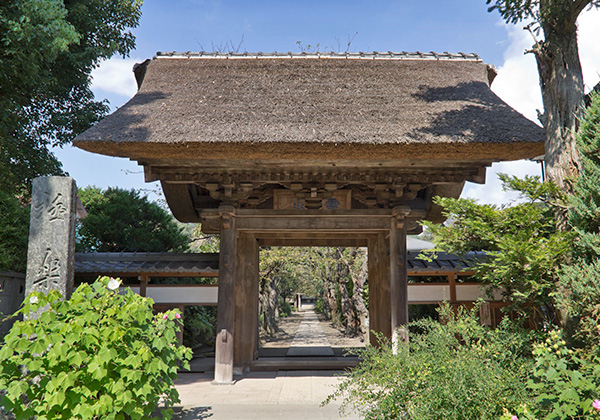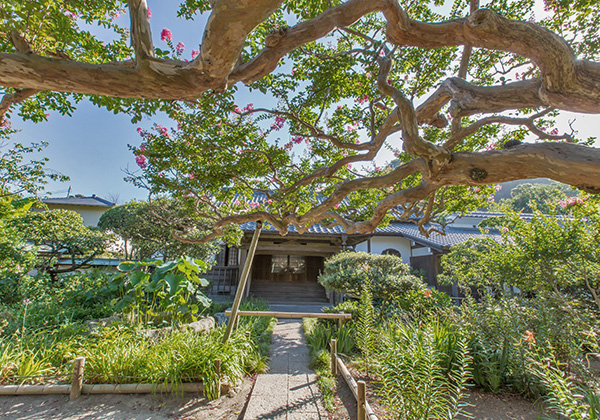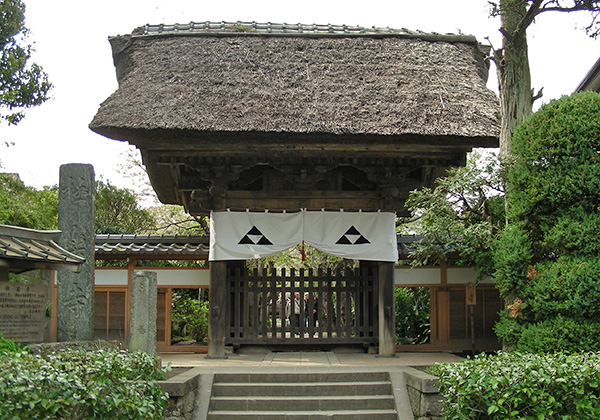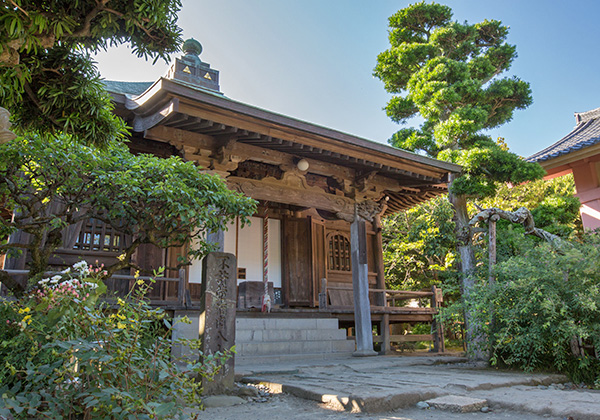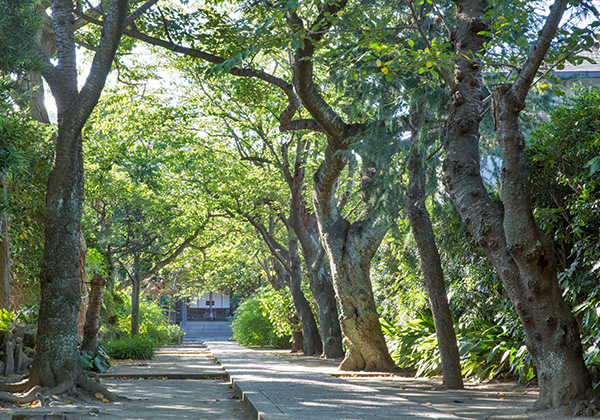Gokurakuji
| Official Name | Ryojusen Kan'no-in Gokurakuji {Pronounced ryo-jew-sen kan'noh-in go-koo-rah-koo-gee} |
|---|---|
| Religious sect | Shingon Ritsu {re-tsu} Sect, Buddhism |
| Founded | in 1259 by Shigetoki Hojo {she-geh-toh-key hoh-joe} |
| Founding priest | Ninsho Ryokanbo (1217-1303) |
| Main object of worship | Statue of Shaka Nyorai {shah-kah nyo-rye} |
| Address | 6-7, Gokurakuji 3-chome, Kamakura, Kanagawa 248-0023 (show route from current location ) |
| Location | 2,200 meters west-northwest of Kamakura Station |
| Time needed to get there | 35 minutes |
| Admission | Free (300 yen for the mini-museum, which is open only on Tuesdays, Thursdays, Saturdays, and Sundays from 4/25 to 5/25 and 10/25 to 11/25). |
| Open | 9:00-16:30 |
| Phone number | 0467-22-3402 |
| Note | No photo or video in the premises |
Historical Overview
This is the only temple in Kamakura that belongs to the Shingon Ritsu sect. Founding priest Ninsho (1217-1303) is well known for devoting his entire life to philanthropic activities. He was born in Nara Prefecture. At the age of 13, he was already a vegetarian honoring one of the Five Buddhist Commandments and studied Shingon Ritsu Buddhism at Saidaiji {sigh-dye-gee} in Nara. In 1252, he came down to Ibaraki Prefecture to propagate Shingon Ritsu doctrines in the Kanto region. At age 44 in 1261, he settled in Kamakura where he built the open-cut path now called Gokurakuji zaka (slope), linking the western part of Kamakura to the central district. Back then, Shigetoki Hojo (1198-1261), the third son of the Second Regent Yoshitoki Hojo, was building his residence in this vicinity. The open-cut path greatly helped transport lumber and other building materials. Priest Ninsho's efforts led to a closer relationship between the two. He even performed invocations and prayers for Tokiyori Hojo (1227-1263), then the Fifth Hojo Regent and nephew of Shigetoki, at the time Tokiyori got seriously sick in 1261, and also at the time Mongol troops tried to invade Japan in 1281. Through these cooperative actions for the Hojos, Priest Ninsho gained their trust.
Shigetoki Hojo had lived in Kyoto as a military commander for 18 years but returned to Kamakura in 1247 at the request of Tokiyori. While stationed in Kyoto, Shigetoki had already known Priest Ninsho. Moved by Priest Ninsho's preaching and his energetic activities in Kamakura, Shigetoki sponsored to build the Temple, but he had died in late 1261 shortly before the construction was completed. His sons Nagatoki {nah-gah-toh-kee} (1230-1264) and Naritoki {nah-re-toh-kee} (1241-1287) continued to support and the temple construction was finished in 1267. (Note the founding year was 1259.) Naturally, Priest Ninsho was appointed as the founding priest.
Priest Ninsho never stopped his religious activities as well as civil engineering serving the public at large for nearly four decades until his death in 1303 at the age of 87. He constructed hospitals and nursing homes for the sick and the poor. Records show that no fewer than 60,000 sick and poor people were treated in the 20-year period. Most distinguished among them was a sanitarium he built for those suffering from Hansen's disease. Physical deformities of the patients that result from the disease and appear on visible body parts such as the fingers and faces were the cause of the extreme discrimination against the sufferers. With no cause of the disease known those days, people thought it was hereditary, and resulted in strong bias against even sufferer' blood relatives. They were ostracized and people did not want to get close to them. Even in the Old Testament, the Lord says "an open sore means a dreaded skin disease and are unclean" (Leviticus 13-15). In modern Japan, discrimination against those with the disease still continued and the government maintained a policy of isolating the patients, forcing them to stay in sanatoriums located in a small island off Takamatsu city, Kagawa Prefecture and Kumamoto Prefecture. Not until March 1996 did the government annulled the law, although it was known well before World War II that the disease could be cured. But, a group of former patients filed a lawsuit in March 1999 against the National Government demanding compensation for long-term mental anguish they claim to have suffered as a result of the government's discriminatory policy. In May 2001, the District Court in Kumamoto ruled that the policy was illegal and ordered the state to compensate the former patients, followed by Prime Minister Koizumi's apology to them, nearly 4,500.
Seeing those patients in predicament, Priest Ninsho took the initiative in rescuing them. A large stone pestle and mortar standing today near the Temple's main hall are reminiscent of old days. They were used to grind herbal medicine for the sick. In addition to the medical practice, he undertook civil engineering such as road and bridge construction. To be specific, he built 83 temples, 189 bridges and 71 roads. Included among them was the aforementioned excavation of an open-cut on the hill lying just east of the Temple to connect the Gokurakuji district to central Kamakura. With no bulldozer, no truck, no power machines available, it must have been a tremendously hard work. After his demise, Emperor Godaigo conferred him in 1328 with a title of "Bosatsu" {boh-sah-tsu} (Bodhisattva in Sanskrit.) in praise of his humanitarian works and virtue. People admired him as a living Bodhisattva. If he were living today, he might well have been the Japanese counterpart of Mother Teresa or a Japanese Good Samaritan. Some criticized him, however, like Priest Nichiren, the founder of Nichiren sect Buddhism, pointing out that Priest Ninsho was too close to the Hojo regime and hunting for concessions. There was constant antagonism between the two religious leaders. Priest Ninsho asserted that Buddhist priests should take actions for the sick, poor and weak rather than delivering sermons at a street corner.
According to an ancient sketch map, the Temple had at its heyday a huge complex. About 800 by 900-meter-area was originally within the confines of the Temple. In the compounds were seven main buildings and as many as 49 sub-temples. Together with Saidaiji in Nara, the Temple was the headquarters of Shingon Ritsu sect covering eastern part of Japan. Unfortunately, however, the warfare in 1333 when Yoshisada Nitta {yo-she-sah-dah nit'tah} (1302-1338) attacked Kamakura and brought the collapse of the Hojo regime, ruined most structures of the Temple. Although the complex was restored afterwards to some extent, the Temple was no longer able to obtain such a powerful patronage as the Hojos had been giving. Fires in 1425 and 1572, and earthquakes in 1433 wreaked havoc on them. In the late 16th century, there were reportedly only four structures.
Most of the current structures we see today were reconstructed after the Great Kanto Earthquake of 1923. The size of present temple premises measures only 5,000 square meters or so. The ground of Inamuragasaki {e-nah-moo-rah-gah-sah-key} Elementary School which lies due north of the Temple, for example, was part of the ancient Gokurakuji premises. Nevertheless, the Temple keeps many valuable statues and Buddhist fittings.
